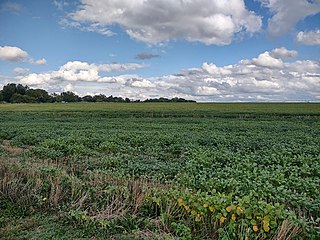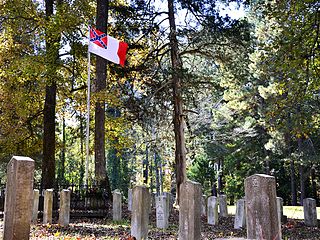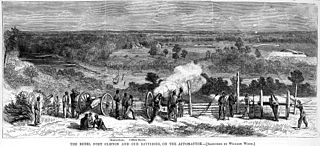
The Battle of Richmond, Kentucky, fought August 29–30, 1862, was one of the most complete Confederate victories in the war by Major General Edmund Kirby Smith against Union major general William "Bull" Nelson's forces, which were defending the town. It was the first major battle in the Kentucky Campaign. The battle took place on and around what is now the grounds of the Blue Grass Army Depot, outside Richmond, Kentucky.

Fort Pillow State Historic Park is a state park in western Tennessee that preserves the American Civil War site of the Battle of Fort Pillow. The 1,642 acre (6.6 km²) Fort Pillow, located in Lauderdale County on the Chickasaw Bluffs overlooking the Mississippi River, is rich in both historic and archaeological significance. In 1861, the Confederate army built extensive fortifications and named the site for General Gideon Johnson Pillow of Maury County. It was attacked and held by the Union Army for most of the American Civil War period except immediately after the Battle of Fort Pillow, when it was retaken by the Confederate Army. The battle ended with a massacre of African-American Union troops and their white officers attempting to surrender, by soldiers under the command of Confederate Major General Nathan Bedford Forrest.
The Battle of Fort Davidson, also known as the Battle of Pilot Knob, was a battle of Price's Missouri Expedition fought on September 27, 1864, near Pilot Knob, Missouri. Confederate troops under the command of Major-General Sterling Price had entered Missouri in September 1864 with hopes of challenging Union control of the state. On September 24, Price learned that Union troops held Pilot Knob. Two days later, he sent part of his command north to disrupt and then moved towards Pilot Knob with the rest of his army. The Confederate divisions of Major-General James Fagan and Brigadier-General John Marmaduke drove Union troops under Brigadier-General Thomas Ewing and Major James Wilson from the lower Arcadia Valley into Fort Davidson on September 26 and on the morning of September 27.

The Second Battle of Newtonia was fought on October 28, 1864, near Newtonia, Missouri, between cavalry commanded by Major General James G. Blunt of the Union Army and Brigadier General Joseph O. Shelby's rear guard of the Confederate Army of Missouri. In September 1864, Confederate Major General Sterling Price had entered the state of Missouri with hopes of creating a popular uprising against Union control of the state. A defeat at the Battle of Pilot Knob in late September and the strength of Union positions at Jefferson City led Price to abandon the main objectives of the campaign; instead he moved his force west towards Kansas City, where it was badly defeated at the Battle of Westport by Major General Samuel R. Curtis on October 23. Following a set of three defeats on October 25, Price's army halted to rest near Newtonia on October 28.
The Battle of Poison Spring was fought in Ouachita County, Arkansas on April 18, 1864, as part of the Camden Expedition, during the American Civil War. A Union force commanded by Major General Frederick Steele had moved from Little Rock, Arkansas towards Shreveport, Louisiana in support of Major-General Nathaniel Banks' move up the Red River towards Shreveport. After Banks was defeated at the battles of Mansfield and Pleasant Hill, Steele was isolated in Arkansas. Short on supplies, Steele sent a detachment commanded by Colonel James M. Williams to search for supplies. Williams' column was attacked by Confederate troops under the command of Brigadiers General John S. Marmaduke and Samuel B. Maxey. After a sharp fight, Williams' command was routed, losing its wagon train and four cannons. The defeat at Poison Spring and another defeat at the Battle of Marks' Mills a week later led Steele to retreat to Little Rock. The battle is infamous for the Confederates' slaughter and mutilation of African-American Union soldiers of the 1st Kansas Colored Infantry. Poison Springs Battleground State Park, which is part of the Camden Expedition Sites National Historic Landmark, preserves a portion of the site of the battle.

The Richmond National Battlefield Park commemorates 13 American Civil War sites around Richmond, Virginia, which served as the capital of the Confederate States of America for most of the war. The park connects certain features within the city with defensive fortifications and battle sites around it.
The Battle of Paducah was fought on March 25, 1864, during the American Civil War. A Confederate cavalry force led by Maj. Gen. Nathan Bedford Forrest moved into Tennessee and Kentucky to capture Union supplies. Tennessee had been occupied by Union troops since 1862. He launched a successful raid on Paducah, Kentucky, on the Ohio River.
The Camden Expedition was the final campaign conducted by the Union Army in Arkansas during the Civil War. The offensive was designed to cooperate with Major-General Nathaniel P. Banks' movement against Shreveport.

Fort Lookout, also known as Redoubt A, is a defensive earthworks erected during the American Civil War on the outskirts of Camden, Arkansas. It was the northernmost of a series of five redoubts built in defense of the city by Confederate Army forces in early 1864, preparatory to the Union Army's Camden Expedition. The site has been designated a National Historic Landmark as part of the Camden Expedition Sites, a collection of military sites related to the expedition.

Fort Southerland, also known as Redoubt E and possibly Fort Diamond, is a redoubt built during the American Civil War to protect Camden, Arkansas. Confederate forces built it along with four other redoubts in early 1864 after a Union victory in the Little Rock campaign the previous year. Fort Southerland is about the size of a city block and is roughly oval. It could hold three cannons. When Union forces captured Camden in April 1864 during the Camden Expedition, they improved the defenses of the five redoubts, which were not sufficient for proper defense of the city. After the Confederates retook Camden later that month, they continued to improve the city's defenses.

The Thompson and Powell Martyrs Monument is a memorial to two Confederate soldiers in Saint Joseph, Kentucky. It is on the National Register of Historic Places (NRHP), one of only three NRHP locations in Daviess County, Kentucky that is not in Owensboro, Kentucky.

The Confederate Monument of Morganfield, Kentucky is a monument to Confederate soldiers from surrounding Union County, Kentucky, of which Morganfield is the county seat. It is in the northernmost corner of the City Cemetery/Odd Fellows Cemetery just outside downtown Morganfield. During the War "Union" County was mostly a Confederate-sympathizing county. The county produced 657 soldiers for the Confederacy, but only 187 for the Union, although 131 African-Americans joined the Union forces in 1864. In July 1862, Union forces at Caseyville, Kentucky threatened to arrest everyone in the town of treason, eventually freeing all but nineteen citizens. A skirmish in Morganfield on September 1, 1862, resulted in a Confederate victory.

Fort Granger was a Union fort built in 1862 in Franklin, Tennessee, south of Nashville, after their forces occupied the state during the American Civil War. One of several fortifications constructed in the Franklin Battlefield, the fort was used by Union troops to defend their positions in Middle Tennessee against Confederate attackers. The Second Battle of Franklin in 1864, part of the Franklin-Nashville Campaign in the Western Theater, was the most notable engagement of this area during the Civil War.

The Camp White Sulphur Springs Confederate Cemetery is an American Civil War cemetery in Arkansas. It is located northeast of the village of Sulphur Springs, also known as White Sulphur Springs, in Jefferson County.

Fort Clifton Archeological Site is a historic American Civil War fort archaeological site located at Fort Clifton Park, Colonial Heights, Virginia. The park is the site of Fort Clifton on the Appomattox River where five Union ships sailed on Confederate troops on June 11, 1864. The Confederate Battery, with cannon emplacements, remained in Confederate hands as the cannons drove the Union attackers away. The park has earthworks that criss-cross the property. Fort Clifton Park has hiking trails and Civil War campaign signage on site.
Caseyville is an unincorporated community in Union County, Kentucky, United States. Caseyville is located on the Ohio River and Kentucky Route 1508, 4.5 miles (7.2 km) west of Sturgis.

The Weston Bluff Skirmish Site, on a bluff over the Ohio River just north of Weston, Kentucky, was site of an American Civil War skirmish on June 21, 1864. A 10 acres (4.0 ha) area was listed on the National Register of Historic Places in 1998.

The 1st Missouri Field Battery was a field artillery battery that served in the Confederate States Army during the American Civil War. The battery was formed by Captain Westley F. Roberts in Arkansas in September 1862 as Roberts' Missouri Battery and was originally armed with two 12-pounder James rifles and two 6-pounder smoothbore guns. The unit fought in the Battle of Prairie Grove on December 7, as part of a Confederate offensive. Roberts' Battery withdrew after the battle and transferred to Little Rock, Arkansas, where Roberts resigned and was replaced by Lieutenant Samuel T. Ruffner.

The 8th Missouri Infantry Regiment was an infantry regiment of the Confederate States Army during the American Civil War. From May 1861, the war began affecting events in the state of Missouri. In 1862, Confederate recruiting activities took place in Missouri, and a cavalry regiment was formed in Oregon County, the nucleus being former members of the Missouri State Guard. On September 2, the unit entered Confederate service, but it was reclassified as infantry ten days later. After many of the men transferred to other units, the regiment was reclassified as a battalion on October 19 and named the 7th Missouri Infantry Battalion, also known as Mitchell's Missouri Infantry. It participated in a Confederate offensive at the Battle of Prairie Grove on December 7. During the battle, the unit made several charges against the Union lines but was repeatedly repulsed by artillery fire. The regiment spent most of early 1863 encamped near Little Rock and Pine Bluff in Arkansas.

The Second Battle of Newtonia Site is a battlefield listed on the National Register of Historic Places (NRHP) near Newtonia and Stark City in Missouri. In late 1864, Major General Sterling Price of the Confederate States Army began a raid into Missouri in hopes of diverting Union troops away from more important theaters of the American Civil War. After a defeat at the Battle of Westport on October 23, Price's Army of Missouri began retreating through Kansas, but suffered three consecutive defeats on October 25. By October 28, the retreating Confederates had reached Newtonia, where the Second Battle of Newtonia broke out when Union pursuers caught up with the Confederates. Confederate cavalry under Brigadier General Joseph O. Shelby was initially successful, but after Union reinforcements under Brigadier General John B. Sanborn counterattacked, the Confederates withdrew. The Union troops did not pursue, and Price's men escaped, eventually reaching Texas by December.
















